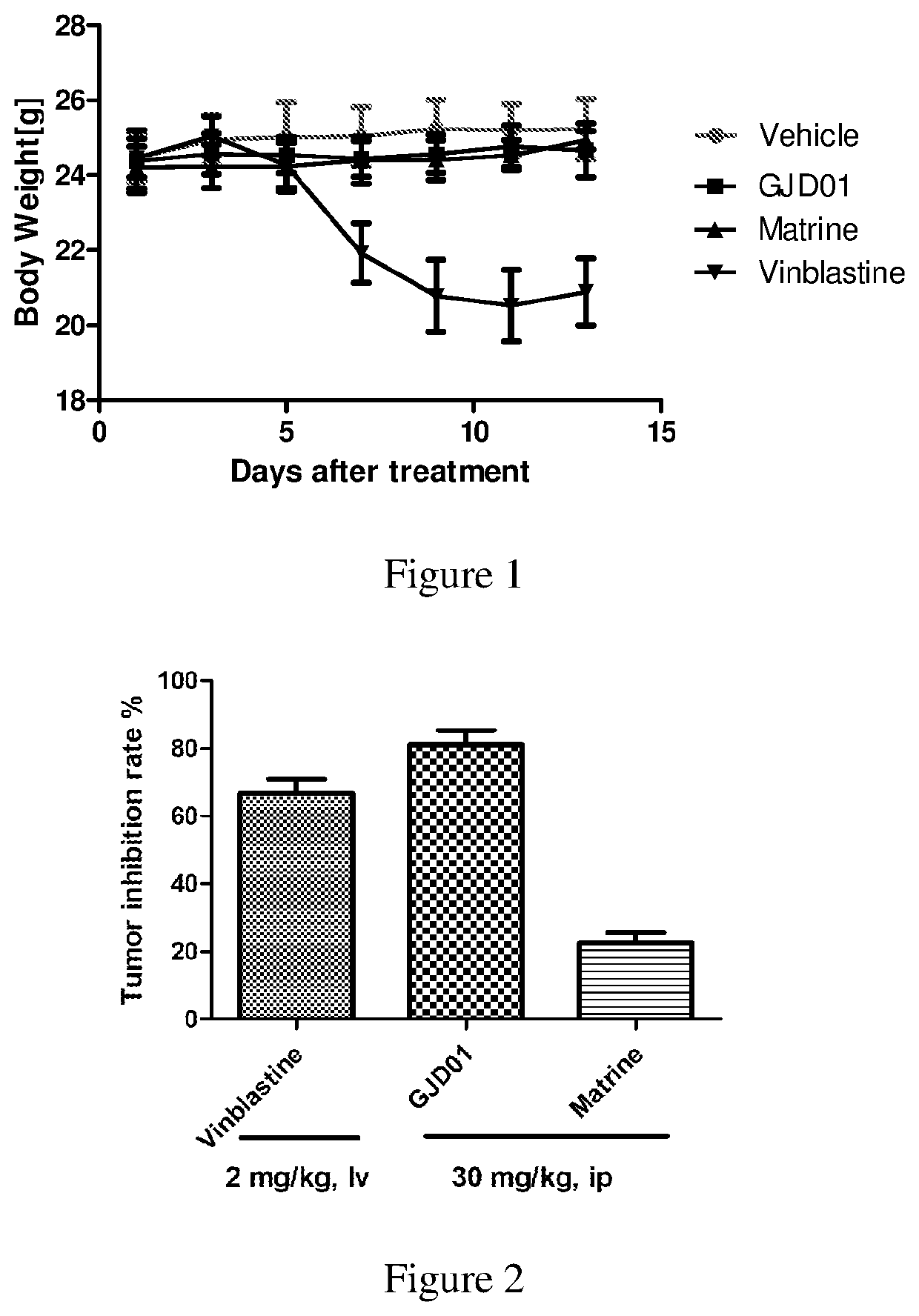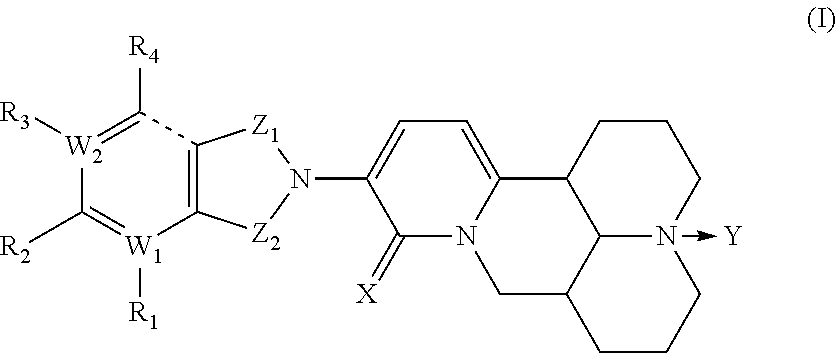MATRINE a-KETOAMINE COMPOUNDS, PREPARATION METHOD THEREFOR AND USE THEREOF
- Summary
- Abstract
- Description
- Claims
- Application Information
AI Technical Summary
Benefits of technology
Problems solved by technology
Method used
Image
Examples
example 1
of Compound M-3
[0082]
[0083]Step 1: Preparation of Intermediate M-1
[0084]To a stirred solution of matrine (4.96 g, 20 mmol) and triethylamine (4.04 g, 40 mmol) in dichloromethane (200 mL) was slowly added trimethylchlorosilane (2.60 g, 24 mmol) under an ice bath, after 1 h, iodine (6.10 g, 24 mmol) was added, and the reaction was continued for the further 3 to 5 hours at this condition. After the reaction was completed, quenching with 200 ml of 10% sodium thiosulfate solution, followed by extraction with dichloromethane (200 mL×3). The combined organic phases were sequentially washed with saturated sodium bicarbonate, saturated brine, dried over anhydrous sodium sulfate, and filtered. The resulting filtrate was evaporated under reduced pressure and purified by silica gel column chromatography (Vchloroform:Vmethanol=30:1 to 10:1) to obtain M-1 (6.88 g, yield 92%). MS-ESI [M+H]+ 375.1 (375.1).
[0085]Step 2: Preparation of Intermediate M-2
[0086]An aqueous solution (6.7 mL) of sodium azid...
example 2
Synthesis of Compound M-3′
[0089]
[0090]Step 1: Preparation of Intermediate M-1′
[0091]To a stirred solution of sophoridine (4.96 g, 20 mmol) and triethylamine (4.04 g, 40 mmol) in dichloromethane (400 mL) was slowly added trimethyliodosilane (2.00 g, 10 mmol) under an ice bath, after 1 h, iodine (6.10 g, 24 mmol) was added, and the reaction was continued for the further 3 to 5 hours at this condition. After the reaction was completed, quenching with 200 ml of 10% sodium thiosulfate solution, followed by extraction with dichloromethane (200 mL×3). The combined organic phases were sequentially washed with saturated sodium bicarbonate, saturated brine, dried over anhydrous sodium sulfate, and filtered. The resulting filtrate was evaporated under reduced pressure and purified by silica gel column chromatography (Vchloroform:Vmethanol=30:1 to 10:1) to obtain M-1′ (6.72 g, yield 90%). MS-ESI [M+H]+ 375.1 (375.1).
[0092]Step 2: Preparation of Intermediate M-2′
[0093]An aqueous solution (6.7 mL...
example 3
Synthesis of Compound GJD-1
[0096]
[0097]To a stirred solution of M-3 (53 mg, 0.2 mmol) and triethylamine (30 mg, 0.3 mmol) in tetrahydrofuran (1 mL) was added N-formylmethyl-substituted phthalimide (45 mg, 0.22 mmol), and the reaction was heated to 60° C. for overnight. After the reaction was completed, filtered, and the filtrate was evaporated and purified by silica gel column chromatography (Vchloroform:Vmethanol=40:1 to 20:1) to give the compound GJD01 (68 mg, yield 76%) of example 3. HRMS-ESI: m / z calcd for C23H27N3O3: 393.2052, found [M+H]+ 394.2126; 1H NMR (300 MHz, CDCl3) 7.90-7.74 (m, 2H), 7.73-7.59 (m, 2H), 4.70 (dd, J=12.9, 5.4 Hz, 1H), 4.34 (dd, J=13.0, 4.4 Hz, 1H), 3.98 (td, J=10.6, 5.4 Hz, 1H), 3.22 (t, J=12.9 Hz, 1H), 2.92-2.73 (m, 2H), 2.60-2.46 (m, 1H), 2.38-2.30 (m, 1H), 2.07-1.88 (m, 5H), 1.77-1.38 (m, 10H). 13C NMR (101 MHz, CDCl3) δ 168.0 (2C), 165.7, 133.9 (2C), 132.2 (2C), 123.4 (2C), 63.2, 57.2, 57.1, 53.3, 50.3, 43.9, 41.7, 34.9, 27.7, 27.1, 26.2, 24.2, 21.1, ...
PUM
| Property | Measurement | Unit |
|---|---|---|
| Mass | aaaaa | aaaaa |
| Mass | aaaaa | aaaaa |
| Fraction | aaaaa | aaaaa |
Abstract
Description
Claims
Application Information
 Login to View More
Login to View More - R&D Engineer
- R&D Manager
- IP Professional
- Industry Leading Data Capabilities
- Powerful AI technology
- Patent DNA Extraction
Browse by: Latest US Patents, China's latest patents, Technical Efficacy Thesaurus, Application Domain, Technology Topic, Popular Technical Reports.
© 2024 PatSnap. All rights reserved.Legal|Privacy policy|Modern Slavery Act Transparency Statement|Sitemap|About US| Contact US: help@patsnap.com










